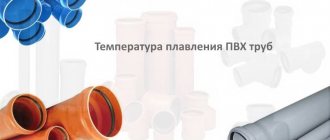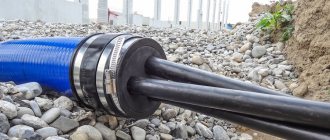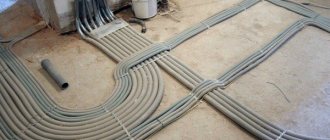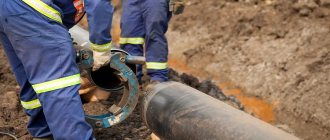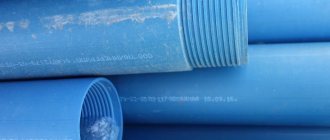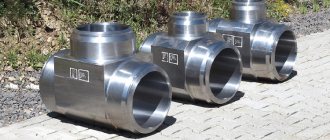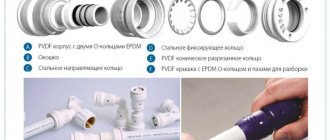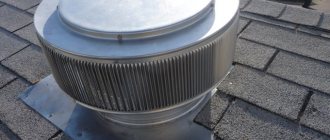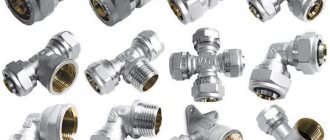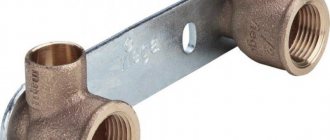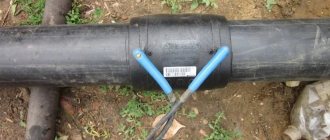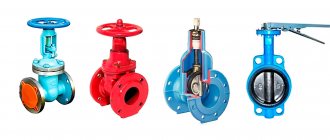The melting point of various types of polyethylene ranges from 103 to 137°C.
Analyzing this indicator, we can divide all varieties of this polymer into two large groups. Representatives of the first group have a melting point ranging from 103 to 110°C, while those of the second group range from 130 to 137°C. The differences are due to the fact that there are two fundamentally different technologies for the production of polyethylene. Therefore, the properties of materials obtained using different technologies differ markedly.
At a pressure of 100-288 MPa, polyethylene with a low specific gravity is synthesized. In Russia it is most often referred to by the abbreviation LDPE (high pressure), and abroad - LDPE (low density polyethylene).
Unlike the first method, high-density polyethylene is produced by synthesis at low pressure (0.1-0.495 MPa). The internationally accepted designation for this material is HDPE (High Density Polyethylene), and in our case it is HDPE (that is, low pressure).
Most polyethylene products made in Russia have international markings - HDPE or LDPE. We will also adhere to terminology accepted throughout the world.
What is the substance
The structure of the polyethylene molecule is quite simple. It looks like a chain that consists of carbon atoms. Each of them is joined by 2 hydrogen molecules. There are two modifications of this substance in the world. They are different in structure. This is also reflected in the properties that polyethylene has (melting and boiling points, consumer properties). The only thing that unites them is their origin. Both modifications are obtained from ethylene.
The first type of polyethylene consists of linear monomers. Their degree of polymerization is 5000 or more. The second modification has monomer branches. They consist of carbon atoms (from 4 to 6).
To create linear polyethylene, special catalysts are used. The polymerization process occurs at temperatures up to 150 °C.
Characteristics
A thermoplastic polymer, which is characterized by opacity in a thick layer, is polyethylene. The melting point and technical features of the material make it popular. It crystallizes in the range from -60 to -269 °C.
Its main positive quality is the absence of wetting of polyethylene with water. At home, it is not exposed to various organic solvents. It also does not react at room temperature with aqueous salt, acid and alkaline solutions.
When the temperature rises to 60 °C, the material becomes vulnerable to sulfuric and nitric acids. When using oxidizing agents to treat the surface of polyethylene, one should expect destruction of the surface layer. The material begins to become wetted with water. This quality is necessary for gluing polyethylene.
Polymerization methods
Depending on the method of polymerization of ethylene, polyethylene comes in 3 types: low, high pressure and linear type of material. This determines what qualities polyethylene will have. The melting point and technical properties of each variety are different. Therefore, they are used in almost every field of human activity.
High pressure polyethylene is softer. It is polymerized using the radical method. The pressure reaches 1-3 thousand atm. The temperature is 180 °C. Oxygen in this case participates as an initiator.
Low-density polyethylene is produced using Ziegler-Natta catalysts. An organic solvent also takes part in this process. The working pressure is at least 5 atm, and the temperature exceeds 80 °C.
Linear (medium) polyethylene is an intermediate material between the varieties considered. This concerns its qualities and properties. It is produced at a pressure of 30-40 atm. When using metallocene catalysts, it is possible to obtain a product with increased strength.
Forum members talk about the secrets of choosing and installing HDPE pipes for bringing drinking water into the house
For an autonomous water supply system to work at its best, it needs high-quality components.
We have already written about how to make an Abyssinian well yourself, or what features need to be taken into account when choosing a water supply system for a private house.
It’s time to tell FORUMHOUSE readers what you need to know about the features of HDPE pipes.
HDPE pipe - how to choose
HDPE is the most popular material for introducing cold water into the house (from a well, etc.).
And yet, novice developers have many questions in connection with its use:
- What is a HDPE pipe;
- How to choose it;
- How to distinguish a quality product from a fake;
- How durable is the HDPE pipe for cold water supply?
- What features need to be taken into account during installation?
Alex286:
– It is correct to say PE (polyethylene), and not HDPE, of course, provided that the pipes are made in accordance with GOST 18599-2001 “Polyethylene pressure pipes”.
HDPE is the raw material (low-density polyethylene) from which PE products are made.
But, like FORUMHOUSE users, we will stick to the “popular” name.
The service life of the pipeline largely depends on the quality of the feedstock. And if in some cases the HDPE water main lasts for decades, then in other cases even a properly installed system begins to leak after 1-1.5 years.
The fact is that many companies use plastic waste – the so-called “recycled material” – in the production of HDPE pipes. Moreover, everything is used, even used disposable syringes. The strength and reliability of such products does not stand up to criticism. And cold water from them has a sharp, unpleasant chemical odor that does not disappear even with time.
Pls:
– The easiest way to choose a high-quality HDPE pipe intended for supplying drinking water is to pay attention to its appearance.
A low-quality product is black or dark gray in color. There are no letter or number markings on it. Alien inclusions or stripes are noticeable in the material. If you smell the product, you can smell an unpleasant chemical odor. Its walls are of different thicknesses (visible when viewed from the end).
This design can only be used for supplying process water.
HDPE design intended for drinking water - black with blue stripes or completely blue. Its color is uniform, the material itself is smooth, without inclusions or stripes. The wall thickness corresponds to GOST. Marking is required (embossed or printed for marking) - “Drinking pipe GOST 18599-2001”. The following must also be indicated:
- Diameter;
- Wall thickness;
- Manufacturer;
- The strength indicator of the material is marked as follows: PE100 or PE80.
PE100 polyethylene has a higher density, and therefore strength (withstands higher pressure) than PE80 polyethylene.
Banned:
– I advise you to choose products that have GOST stamped on them, have the manufacturer’s markings and the footage is indicated.
Alex286:
– In accordance with GOST 18599-2001, according to which pipes for water supply are made, the presence or absence of blue stripes on a HDPE pipe does not indicate whether it is intended for drinking water or not.
Some unscrupulous manufacturers may apply blue stripes to low-quality HDPE pipes or those intended for technical needs. Therefore, first of all, you need to look at what is written on the product itself!
The water pipe according to GOST 18599-2001 is made only from low-density polyethylene without the addition of recycled materials.
You also need to pay attention to the price - compare the price tags of several manufacturers. A price significantly lower than the maximum and even the market average should be alarming, because the manufacturer will not trade at a loss.
How to set up connections
It is not enough to choose a quality product; it is necessary to lay the pipeline correctly and install reliable connections. Most often, HDPE water connections are made using collet fittings.
Because There are no metal parts in the flow part of compression fittings, which increases the corrosion resistance of the pipeline system made of this material.
When installing on push-in fittings, there are some considerations that need to be taken into account.
KVladimir:
- I assembled the system. Despite the use of fum tape and decent tightening, some HDPE fittings leak.
When installing a collet fitting, you should not use flax, tow or fum tape “for additional reliability.”
www.forumhouse.ru
The reason for the differences in the properties of polyethylene
The branching structure of macromolecules determines the properties that polyethylene has. Melting point and density depend on the type of chain. The more branches it has, the more elastic the material with less crystalline properties is obtained at the output.
This structural feature makes it difficult to form a denser packing of macromolecules and becomes an obstacle to a 100% level of crystallinity. The material also has an atmospheric phase. It contains insufficiently ordered sections of molecules. The production method determines the ratio of crystalline and atmospheric phases. It is this feature that affects the properties of polyethylene.
Therefore, films that are produced under low pressure are more permeable than other varieties. The higher the crystallinity (molecular weight), the higher the mechanical properties. Therefore, in the form of a film, the material is transparent and elastic. But polyethylene sheets will be rigid and opaque.
Application area
HDPE film is used:
- For packaging dry industrial and various bulk goods,
- For food non-oxidizing products,
- For products that need to be cooked in the package,
- Instead of greaseproof paper,
- In construction, agriculture and other industries as an insulating layer,
- For laminating paper and cardboard.
IMPORTANT! Perforated HDPE film allows you to store in it even goods that require access to fresh air and regular ventilation (fruit, etc.).
Impact of temperature
Under the influence of the environment, the qualities endowed with polyethylene change. The melting point of this substance also depends on the production method. In general, when heated, polyethylene goes through several stages. At first it becomes softer and more elastic. It is easily deformed under mechanical influences.
The brittleness temperature at which average polyethylene loses its strength characteristics is 70 °C. With further increase, the substance softens even more. It completely loses its previously existing shape when heated to 120 °C. It turns into a liquid substance at a temperature of 130 °C.
Read also: Where do you study to become an electrical engineer?
In addition to the heating temperature, it is necessary to take into account the effect of ultraviolet radiation. If the material is used for outdoor products, it is necessary to choose more durable varieties. Otherwise, soft, elastic polyethylene will become hard and brittle after a year of use in direct sunlight. Even the color of the material changes over time.
Low-pressure polyethylene
Each type of material has special qualities. This expands the range of applications that polyethylene has. Melting point (high density) is 120-135 °C. Some brands have a heat resistance of 110 °C. High molecular density improves thermal and impact resistance.
In addition to the listed qualities, low-density polyethylene is less susceptible to chemical influences. However, the excessive density of molecules at low temperatures makes the material brittle and becomes permeable to vapors and gases.
This type of material has good dielectric characteristics. It is biologically inactive, but is easily processed in industrial production.
Classification of technical HDPE products
The main regulatory document regulating the production of technical polyethylene pipes is TU 2248 002 50930589 2005. According to these technical conditions, a technical polyethylene pipe can have a diameter from 16 to 225 mm, while the wall thickness can range from 2 to 20.5 mm.
According to this indicator, pipes are divided into the following types:
- Heavy (T)
- Medium-heavy (MT)
- Lightweight medium (LT)
- Average (C)
- Medium-light (SL)
- Lungs (L)
Polyethylene technical pipes can be made from various types of raw materials; PE 33 is most often used; 63; 80. It is precisely the fact that essentially waste polyethylene of these brands is used for production that significantly reduces the cost of production.
But it is worth considering that it is the properties of such polyethylene that limit its scope of application. Working pressure markings on pipes are not used. The main indicator is SDR (the ratio of the diameter of the product to its wall thickness). The lower the value of this indicator, the more pressure communication can withstand.
↑
Application area
Technical pipes made of polyethylene are not used for the construction of pressure pipelines; they are mainly used for the following purposes:
- Gravity (non-pressure) systems for transporting bulk materials, sewerage, including storm water, drainage.
- Protective devices for laying electrical wiring for various purposes (communications, alarms, electrical power cables, etc.).
In addition, products made from recycled polyethylene are used for the manufacture of devices for autonomous sewerage and other technical products. Pipes can be laid both in the ground and on the surface.
The use of products made of technical polyethylene for laying domestic and drinking water supply systems is prohibited. But this is mainly due to the lack of sanitary standards for such pipes, and not to the chemical composition of the material.
↑
Specifications
The use of recycled materials did not in any way affect the operational and technical characteristics of the product. HDPE technical polyethylene pipes also have significant flexibility, durability, and are resistant to various chemical influences.
The physical properties of technical polyethylene also do not differ from ordinary polyethylene:
- The density of the material is slightly less than the density of water (about 850 kg/cub.m).
- The pipe begins to melt at 130 degrees, and the temperature at which deformation begins (polyethylene softens) is 80 degrees.
- The material has good tensile strength and can elongate more than 3.5 times when stretched.
- The use of a pipe as a protective shell is due to the fact that it is a dielectric.
The conclusion that arises when comparing conventional and technical polyethylene pipes is that the technical characteristics of the products are identical.
Like any material, pipes made of technical polyethylene have both negative and positive qualities.
The disadvantages include:
- Low mechanical strength, especially for impact loads.
- It is impossible to use these products at elevated temperatures.
- In addition, the material is negatively affected by low temperatures; in extreme cold, the pipe becomes brittle.
Advantages of technical polyethylene pipes:
- Light weight
- Resistant to aggressive environments, does not corrode.
- Installation can be carried out in various ways, all of which are quite simple. In addition, products with a diameter of up to 160 mm are produced in the form of coils, the length of the pipe in them can be up to 500 meters, which significantly reduces the number of joints and increases the strength of the entire line.
- And most importantly, the price of technical polyethylene pipes is significantly lower, which makes its use for various purposes justified.
↑
High pressure polyethylene
This group includes elastic, lightweight polyethylene. The melting point and crystallization properties do not allow making high-strength, heat-resistant products from it. Depending on the brand, it may have different densities. Their melting point ranges from 60 to 90 °C.
Just like the previous type of material, high-density polyethylene is stronger if the molecular weight increases. It becomes less susceptible to chemical and ultraviolet influences. But at the same time, its ability to withstand blows is reduced. In severe frosts, cracks and tears appear on such polyethylene. It becomes permeable to vapors and gases.
This material also has good dielectric properties. It is not resistant to fats and oils. But this material is able to restrain radiation rays. Biologically, this material is also inert, but easy to process.
To what temperature can HDPE pipe be soldered?
One-piece pipe connections suitable for durable and reliable use are obtained by welding products. There are two popular methods:
- Butt welding.
- Electrofusion welding.
Modern welding devices are equipped with temperature sensors that control the heating process of the ends, not allowing values above 130-137°C. When this value is reached, the master is notified with an audible signal and/or the unit is automatically turned off. HDPE is a rigid material that can withstand increased loads, therefore its melting point is quite high when compared with LDPE.
To find out more, call our specialists now.
Application of low density polyethylene
The inherent qualities of the material determine the scope of application that polyethylene has. The melting point (the use of this indicator is mandatory when choosing each product) allows you to make packaging and containers from such a substance. The most common way to make containers is by blow molding. These can be containers for cosmetics or perfumes, food containers.
Canisters and containers made of low-density polyethylene are used in the automotive and chemical industries, in the manufacture of barrels and fuel tanks.
The production of packaging films made from similar materials is gaining momentum. It is widely used in the production of pipes and fittings. This is a cheap and durable material. It is capable of displacing other competitive products from the market.
HDPE films
High-density polyethylene is suitable for forming ultra-thin films. They can be used at temperatures above boiling water (up to 120⁰C). Under the influence of temperature, the polymer is easily welded, which facilitates the production of bags.
Characteristics of HDPE film:
- maintaining strength even in sub-zero temperatures down to -50⁰C;
- tensile strength;
- chemical and bacteriological inertness.
High-density polyethylene films are well suited for the production of printed products. Despite the density of the fabric, it is more susceptible to punctures and less flexible. The surface of PVP film and bags does not shine.
Scope of application of HDPE films:
- packaging of bulk industrial and household products that cannot be oxidized;
- as insulation;
- for protection against grease and liquid in cardboard packaging.
Application of high density polyethylene
Polyethylene, whose melting point is lower than that of the previous variety, is used in the production of films for agriculture, the food industry and other technical purposes. Its demand is constantly growing.
Various films for agricultural purposes may have additional reinforcement, and their color is also different. They are used in greenhouses and fields to improve the quality and volume of crops.
Cling films and bags are consumed every year on a larger scale all over the world. This type of material has displaced products made from other materials from the main market segments.
Consumption structure
Polyethylene, the melting point of which determines its area of application, is in great demand all over the world. The structure of material consumption is quite interesting. 60-70% of polyethylene is used to make sheets and films.
Also, a fairly large part of the total production volume is occupied by products produced by injection molding or extrusion. More minor is the production of insulation for electrical wires, pipes and fittings. Polyethylene is also used to produce products by blowing and other things.
In the production of sheets and films, high-density polyethylene (low density) is almost always used. They are made in different ways. The thickness of the films is in the range of 0.03-0.3 mm, and the thickness of the sheets is 1-6 mm.
In addition to packaging, this material can be used to produce sacks, bags, drawer linings, boxes and other containers. The properties that the product must have determine the method of polyethylene production. At the end of production, each type of material is assigned a grade. It helps you choose the right type of material for any industry.
Read also: Kinematic diagram of a belt conveyor
Polyethylene and polypropylene, which are the most important and popular representatives of thermoplastics,
that is, polymers that can reversibly transform into a highly elastic/viscous flow state when heated are classified as polyolefins. It is precisely this property, which allows them to be formed into various products that are durable, light in weight and low cost, as well as repeatedly recycled, which has led to the particular popularity of polyethylene and polypropylene. Naturally, when solving the problems of effective and optimal use of these polyolefins in industry and other sectors of life, it is very important to take into account such parameters as their melting point, the beginning of softening, and the operating temperature range.
Polyethylene is a polymer with a wide temperature range of operation.
Polyethylene, depending on its density, melts at temperatures in the range of 105-135 degrees, and this high-pressure material is subject to melting only at 137 degrees. This parameter, as well as stability at low temperatures, allows you to effectively and safely use polyethylene/products made from it in the range of -60 – +100 degrees.
The so-called “cross-linked” polyethylene differs from conventional polyethylene in its higher technical parameters (melting point - 200 degrees, greater density and strength, resistance to aggressive chemicals, the presence of “shape memory”). It is produced by polymerizing ethylene under high pressure.
Depending on the operating conditions, polyethylene of various densities, its “cross-linked” modification can be used for the manufacture of:
- sewer, drainage and water and gas supply pipes;
- various films;
- plastic containers;
- housings for all-terrain vehicles, boats, various parts, household items, etc.;
- electrical insulating materials;
- body armor;
- thermal insulation materials, etc.
Polypropylene actively dominates various industries
Thanks to its parameters (melting point 164-175 degrees, softening point 140 degrees, less dense but harder than polyethylene), polypropylene, obtained from propylene by polymerization, confidently competes with other plastics, consistently displacing them from various industries. This is also facilitated by its high abrasion resistance, resistance to corrosion cracking, resistance to temperature changes, and excellent thermal insulation characteristics.
Depending on the chemical structure, polypropylene can be:
- isotactic, which differs from other types of this substance by a greater degree of crystallinity, higher strength and hardness, and heat resistance, which allows it to be effectively used in the production of pipes, pipeline fittings, products/parts in electrical engineering, and the automotive industry with increased requirements for the mechanical properties of the material;
- syndiotactic, less durable than isotactic, but quite acceptable in the manufacture of medical products, consumer goods, toys;
- atactic, characterized by chemical instability, but suitable for the production of various types of polymer fibers and construction additives (modifiers, etc.)
Nowadays, being already very popular polymers in various industries, polyethylene and polypropylene, thanks to the possibility of improving their parameters by changing pressure, temperature, and selecting a catalyst, are expanding the scope of their effective use.
We are waiting for you at the office of NPP Simplex LLC in Samara:
Zavodskoye Highway 111 8 (code 846) 8
Properties
: Polyethylene is a plastic material with good dielectric properties. Impact resistant, unbreakable, with low absorption capacity. Physiologically neutral, odorless. Has low vapor and gas permeability. Polyethylene does not react with alkalis of any concentration, with solutions of any salts, carboxylic, concentrated hydrochloric and hydrofluoric acids. Resistant to alcohol, gasoline, water, vegetable juices, oil. Destroyed by 50% nitric acid, as well as liquid and gaseous chlorine and fluorine. Insoluble in organic solvents and swells to a limited extent in them. Polyethylene is resistant when heated in a vacuum and an inert gas atmosphere. But in air it is destroyed when heated already at 80 ° C. Resistant to low temperatures down to –70 °C. Under the influence of solar radiation, especially ultraviolet rays, it undergoes photodestruction (soot and benzophenone derivatives are used as light stabilizers). It is practically harmless; it does not release substances hazardous to human health into the environment. Polyethylene is easily recycled by all major plastics processing methods. Easily modified. Through chlorination, sulfonation, bromination, fluorination, it can be given rubber-like properties, improve heat resistance, and chemical resistance. Copolymerization with other olefins and polar monomers improves cracking resistance, elasticity, transparency, and adhesive characteristics. By mixing with other polymers or copolymers, improve impact strength and other physical properties. The chemical, physical and operational properties of polyethylene depend on the density and molecular weight of the polymer, and therefore are different for different types of polyethylene. For example, LDPE (branched chain polyethylene) is softer than HDPE, therefore films made from low-density polyethylene are stiffer and denser than those made from high-density polyethylene. Their tensile and compressive strength is higher, tear and impact resistance is lower, and permeability is 5-6 times lower than that of LDPE films. Ultra-high molecular weight polyethylene with a molecular weight of more than 1,000,000 has increased strength properties. The temperature range of its operation is from -260 to +120 °C. It has a low coefficient of friction, high wear resistance, resistance to cracking, and chemical resistance in the most aggressive environments.
Read also: Nailers pneumatic nail guns
Properties of HDPE in accordance with GOST 16338-85. 1. Density – 0.931-0.970 g/cm3. 2. Melting point – 125-132 °C. 3. Vicat softening temperature in air – 120-125 °C. 4. Bulk density of granules – 0.5-0.6 g/cm 3 . 5. Bulk density of the powder – 0.20-0.25 g/cm3. 6. Breaking bending stress – 19.0-35.0 MPa 7. Shear strength – 19.0-35.0 MPa. 8. Indentation hardness of the ball under a given load is 48.0-54.0 MPa. 9. Specific surface electrical resistance – 10 14 Ohms. 10. Specific volumetric electrical resistance – 10 16 -10 17 Ohm cm. 11. Water absorption for 30 days – 0.03-0.04%. 12. Dielectric loss tangent at a frequency of 10 10 Hz – 0.0002-0.0005. 13. Dielectric constant at a frequency of 10 10 Hz – 2.32-2.36. 14. Specific heat capacity at 20-25 °C – 1680-1880 J/kg °C. 15. Thermal conductivity – (41.8-44)·10 -2 V/(m·°С). 16. Linear coefficient of thermal expansion – (1.7-2.0)·10 -4 1/°С.
Properties of LDPE in accordance with GOST 16337-77. 1. Density – 0.900-0.939 g/cm3. 2. Melting point – 103-110 °C. 3. Bulk density – 0.5-0.6 g/cm 3 . 4. Hardness by indentation of the ball under a given load – (1.66-2.25) 10 5 Pa; 1.7-2.3 kgf/cm2. 5. Shrinkage during casting – 1.0-3.5%. 6. Water absorption for 30 days – 0.020%. 7. Breaking stress during bending – (117.6-196.07) 10 5 Pa; 120-200 kgf/cm2. 8. Tensile strength – (137.2-166.6) 10 5 Pa; 140-170 kgf/cm2. 9. Specific volumetric electrical resistance – 10 16 -10 17 Ohm cm. 10. Specific surface electrical resistance – 10 15 Ohm. 11. Brittleness temperature for polyethylene with a melt flow rate in g/10 min 0.2-0.3 – not higher than minus 120 °C, 0.6-1.0 – not higher than minus 110 °C, 1.5-2 .2 – no higher than minus 100 °С, 3.5 – no higher than minus 80 °С, 5.5 – no higher than minus 70 °С, 7-8 – no higher than minus 60 °С, 12 – no higher than minus 55 °С C, 20 – not higher than minus 45 °C. 12. Modulus of elasticity (secant) for polyethylene with a density in g/cm 2 0.917-0.921 – (882.3-1274.5) 10 5 Pa; 900-1300 kgf/cm 2, 0.922-0.926 – (1372-1764.7) 10 5 Pa; 1400-1800 kgf/cm2, 0.928 – 2107.8 10 5 Pa; 2150 kgf/cm2. 13. Dielectric loss tangent at a frequency of 10 10 0 Hz – 0.0002-0.0005. 14. Dielectric constant at a frequency of 10 10 Hz – 2.25-2.31.
A comparative analysis of the characteristics of HDPE and LDPE shows that HDPE, due to its higher density, has higher strength indicators: heat resistance, rigidity and hardness, has greater resistance to solvents than LDPE, but is less frost-resistant. The high-frequency electrical characteristics are somewhat worse than those of LDPE (due to catalyst residues), but this does not limit the use of HDPE as an electrical insulating material. In addition, the presence of catalyst residues does not allow the use of HDPE in contact with food products (cleaning of catalysts is required). Due to the denser packing of macromolecules, the permeability of HDPE is approximately 5-6 times lower than that of LDPE. In terms of chemical resistance, HDPE is also superior to LDPE (especially in resistance to oils and fats). But LDPE films are more permeable to gases, and therefore unsuitable for packaging products that are sensitive to oxidation.
Advantages and disadvantages of HDPE
The polymer has the following features that have become competitive advantages:
acceptable wear resistance and resistance to “compression↔stretching” associated with the high crystallinity of the material,
increased heat resistance, HDPE does not change its properties at temperatures from -20 °C to +110ºC,
low friction coefficient,
high moisture resistance, the ability not to interact with aggressive environments,
dielectric properties,
ease of welding, gluing and processing of HDPE.
The main disadvantage of HDPE is aging under the influence of sunlight and ultraviolet rays. This negative property is neutralized with the help of inhibitor additives - benzophenone derivatives, sometimes 2-3% furnace black is added to the polymer structure. Properties of low-density polyethylene The synthetic polymer can be easily molded when heated, which allows the production of products by extrusion, blowing or casting. In the composition of products, HDPE is a solid substance with a waxy, matte surface to the touch. In terms of flammability, polyethylene is classified as difficult to ignite (B1) and normally flammable (B2) materials. Self-ignition occurs at a temperature of + 350°C. The substance is chemically neutral and resistant to salt solutions, insensitive to alkaline and acid-containing solutions of low concentration. It is sensitive to the effects of concentrated nitric and sulfuric acid. The synthetic polymer is non-toxic, so it is possible to produce dishes and food containers from this material. The density of basic grades of polyethylene is more than 0.945 g/cm. The degree of crystallinity of the polymer is 70–80%. When struck, objects made from this polymer produce a ringing sound. This distinguishes HDPE from other polymers and composite materials. “By eye,” HDPE film is distinguished from its high-pressure counterpart by the characteristic matte surface of the material. Release form of HDPE Blown HDPE - specially designed for extrusion molding of bottles and blow molded containers of various sizes. Molding HDPE—adapted for injection molding of parts and products. HDPE film is low-density polyethylene, the characteristics of which ensure high melt fluidity. Indispensable as a raw material for the creation of film and plastic bags. Pipe HDPE—distinguished by increased viscosity and strength, used in the manufacture of pipes. Special component additives and additives improve thermal stability and reduce the coefficient of linear expansion of the polymer.
